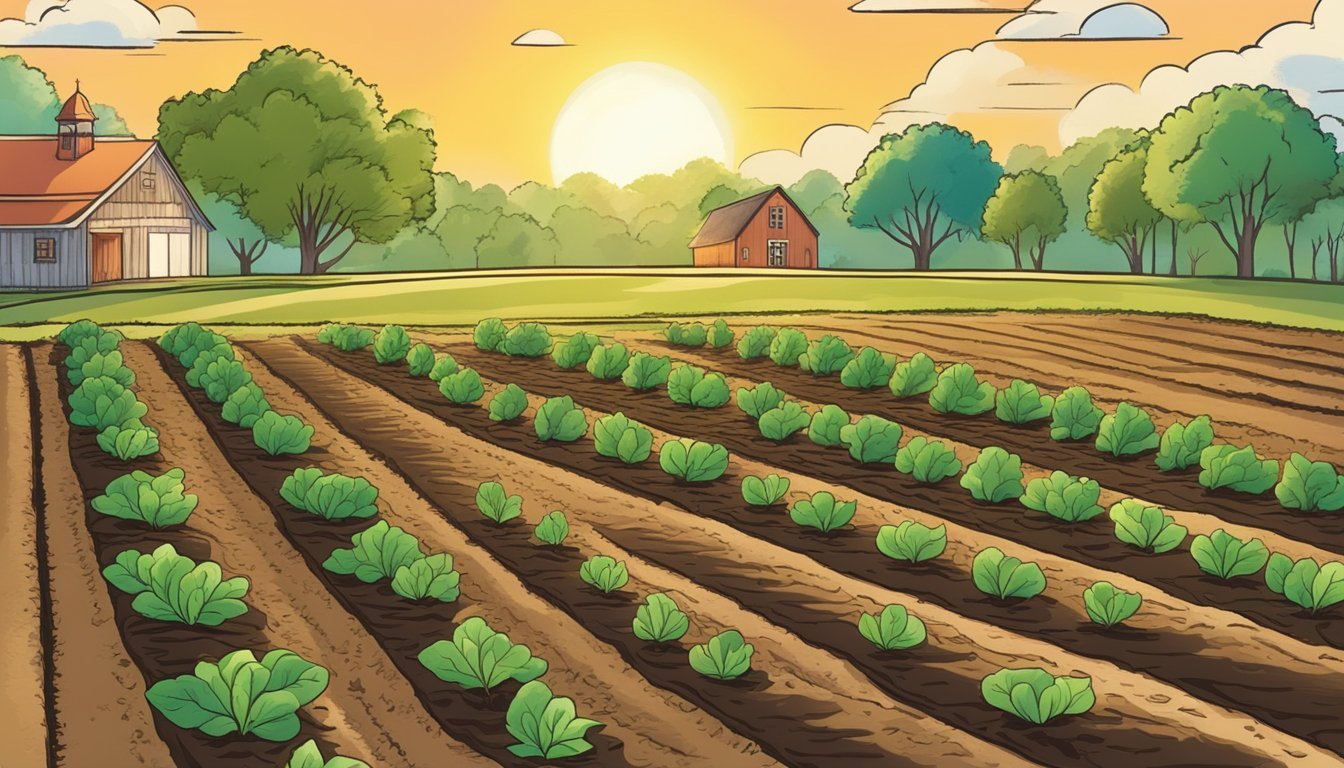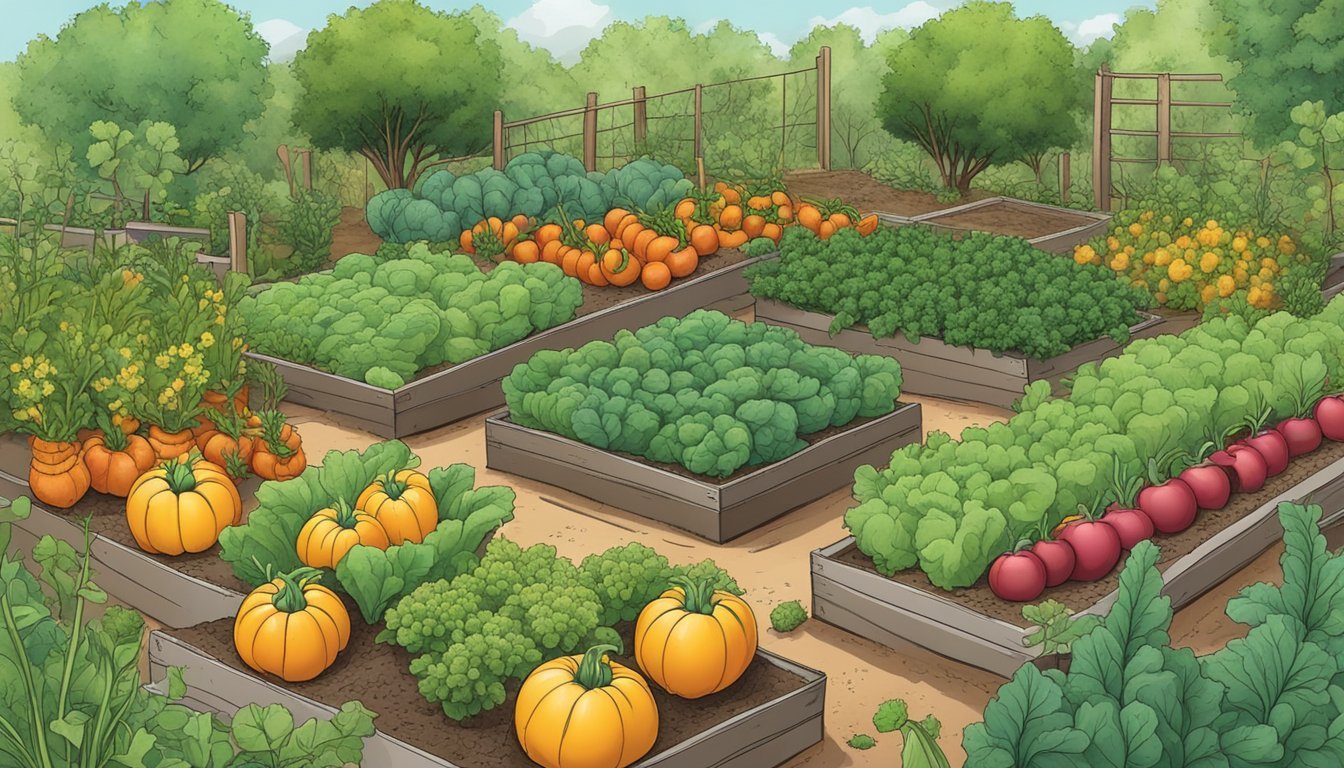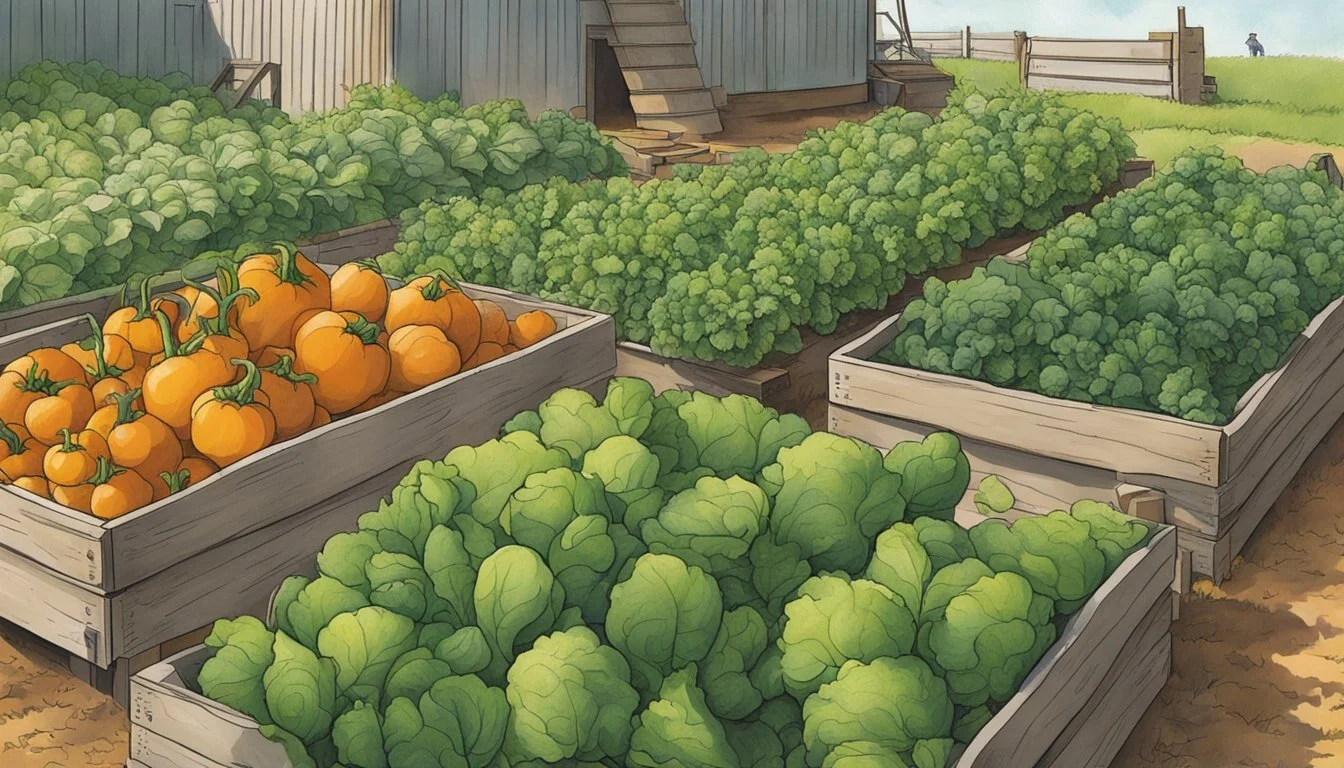Vegetable Gardening in Oklahoma
A Seasonal Guide to Cultivating Your Harvest
This Article is Part of Our Guide on Vegetable Gardening by State
Vegetable gardening in Oklahoma offers a dynamic experience for both novice and expert gardeners due to the state's unique climatic regions. From the humid, warm climates of the east to the drier, more arid west, Oklahoma presents a variety of environments suitable for a diverse range of vegetables. Gardeners in Oklahoma have the opportunity to cultivate a bounty of produce throughout the year, making the most of the state's generally long growing seasons.
Success in growing vegetables in this region hinges on understanding the local weather patterns and selecting appropriate crops for each part of the growing season. Early spring to late fall is the ideal window for planting and harvesting vegetables in Oklahoma. During these months, gardeners can enjoy thriving leafy vegetables such as lettuce, chard, and cabbage, as well as root crops like onions, potatoes, and radishes. The state's soil and climatic conditions are also conducive to peas, squash, tomatoes (What wine goes well with tomatoes?), beans, okra, corn, and asparagus, with each vegetable having specific planting recommendations for optimal growth and yield.
Incorporating variables such as light exposure, water availability, and soil quality is essential for the successful growth of these crops. Even with reduced sunlight, certain vegetables like beans, beets, and broccoli can produce a satisfactory harvest. By taking advantage of the cold hardiness of plants like lettuce, which can withstand frost and snow, gardeners in Oklahoma can extend their planting calendar and enjoy fresh vegetables for most of the year.
Understanding Oklahoma's Climate
The climate of Oklahoma presents unique challenges and opportunities for vegetable gardeners. Knowledge of the local climate conditions and extreme weather events is essential for successful gardening in the state.
Climate and Hardiness Zone
Oklahoma spans across a diverse range of hardiness zones, primarily from 6A to 7B. This variation affects the choice of vegetables that can thrive. Gardeners should reference the USDA Hardiness Zone Map to determine the specific zone for their location, as this directs the selection of plants that are most likely to succeed based on regional temperature extremes.
Seasonal Weather Patterns
The state experiences a wide range of weather patterns throughout the year. Spring and fall are generally mild and are considered the best times for growing cool-season vegetables. Summers tend to be hot and can be ideal for warm-season vegetables. However, gardeners should monitor soil temperature, which should remain at least 40°F for cool-season crops, and higher for warm-season varieties. The state's weather can transition rapidly, making it important to stay vigilant of the local forecast to optimize planting and harvesting schedules.
Extreme Weather Considerations
Gardeners in Oklahoma must be prepared for extreme weather, including periods of intense heat, cold, and the possibility of drought. The selection of drought-resistant vegetable varieties can be beneficial due to the state's susceptibility to dry spells. Additionally, protections against cold, such as frost cloths or cold frames, may be necessary for early spring or late fall plantings to shield crops from unexpected frosts or snow. Understanding these risks can guide gardeners in creating contingency plans, such as irrigation during droughts and protective measures for cold snaps.
Planning Your Oklahoma Vegetable Garden
Successful vegetable gardening in Oklahoma requires understanding the unique climatic conditions of the region and preparing appropriately. The following sections provide guidance on the critical aspects of location selection, planting times, and extending the gardening season for a bountiful harvest.
Selecting the Right Location
A vegetable garden in Oklahoma should be positioned where it receives ample sunlight—6 to 8 hours of direct sun is ideal. The selected location should also have good drainage to prevent water logging, as excess water can impede plant growth and lead to diseases. Gardeners might consider raised beds to improve drainage and soil quality, making sure these beds are placed where they will not be shaded during the day.
Determining Planting Times
Planting times are crucial to match the growing preferences of each vegetable with Oklahoma's variable weather. The state's gardening calendar typically recommends early spring planting for cool-season crops like lettuce, spinach, and peas. In contrast, warm-season crops such as beans, tomatoes, and peppers are best planted after the last spring frost when the soil has warmed. Gardeners can refer to the Oklahoma Cooperative Extension Service's planting guide for specific dates.
Cool-season crops: Plant as early as February to April.
Warm-season crops: Plant from April, after the last frost.
Strategies for Extending Growing Seasons
To maximize the harvest period and protect against Oklahoma's weather extremes, gardeners can employ strategies to extend the growing season. Using cold frames or row covers can shield plants from early spring or late autumn frosts. Drip irrigation systems and mulching will help maintain consistent soil moisture, which is particularly beneficial during hot summers. Adequate water, coupled with timing and protective measures, ensures vegetables can thrive beyond the traditional growing season.
Soil Preparation and Management
Effective soil preparation and management are pivotal for successful vegetable gardening in Oklahoma. They foster fertile soil, promoting healthy plant growth.
Testing and Amending Soil
Before planting, a gardener should test the soil to determine its pH level and nutrient content. This can be done through local extension services or by purchasing a home test kit. Once the gardener has the test results, amending the soil is the next step. If the soil is lacking in nutrients, a balanced blend of fertilizers can be added. For example, nitrogen, phosphorus, and potassium are essential for robust plant growth. Adjusting the pH might require adding lime to raise it or sulfur to lower it, depending on the initial soil conditions.
Importance of Compost and Mulch
Compost is an excellent addition to the garden as it enhances the soil's organic matter, improving both nutrient content and soil structure. A gardener should incorporate a 2- to 3-inch layer of compost into the soil prior to planting. Mulch, on the other hand, is applied to the soil surface. It helps retain moisture, regulate soil temperature, and suppress weeds. A layer of mulch around vegetables can be particularly beneficial during Oklahoma's hot summers.
Irrigation Techniques
Proper irrigation is a key component of vegetable garden management. It's important to water plants deeply yet infrequently to encourage deep root growth and resilience. Techniques such as drip irrigation or soaker hoses are efficient, as they deliver water directly to the plant roots and minimize evaporation. During the planning phase, gardeners should ensure that their garden site is near a water supply to facilitate regular watering throughout the growing season, which is critical in maintaining fertile and productive soil.
Choosing Vegetables to Grow
In Oklahoma, selecting the right vegetables for gardens involves understanding the climate, identifying robust varieties, and using smart planting strategies. Gardeners can achieve bountiful harvests by focusing on these aspects.
Selecting Vegetables for Oklahoma's Climate
Oklahoma's climate can be challenging for gardeners due to its temperature extremes and variable weather. Lettuce is a prime example of a vegetable suited to the state's cooler spring and fall months. Tomatoes, on the other hand, thrive in the warmer temperatures and should be planted after the last frost to avoid cold damage. Gardeners should consider vegetables that can endure the fluctuating conditions typical of Oklahoma.
High-Yield and Easy to Grow Varieties
To maximize their gardens, Oklahoma gardeners should choose high-yield vegetables that are also easy to grow. Here's a list of some recommended vegetables:
Lettuce: Lettuce varieties such as Butterhead, Boston, and Loose Leaf are low-maintenance and cold hardy.
Beans: Beans are adaptable and can produce a large harvest from just a few plants.
Tomatoes: With proper care, tomato plants can yield a plentiful crop throughout the summer.
These vegetables are not only productive but also require less effort, making them an excellent choice for gardeners at all experience levels.
Rotation and Companion Planting
Successful vegetable gardening in Oklahoma also involves rotating crops and planting companions to improve soil health and deter pests. For instance, rotating beans with other crops like lettuce or tomatoes can fix nitrogen in the soil, which is beneficial for leafy vegetables and helps in reducing diseases. Introducing companion plants, such as marigolds alongside tomatoes, can also keep harmful insects at bay while attracting beneficial ones. This practice leads to healthier plants and reduces the need for chemical interventions.
Planting and Cultivation
When planting vegetables in Oklahoma, gardeners should consider methods such as container and raised bed gardening, vertical gardening for effective use of space, and the best practices for sowing seeds and transplanting starters to ensure healthy growth.
Container and Raised Bed Gardening
Gardeners in Oklahoma often turn to containers and raised beds to overcome challenges posed by local soil conditions. Containers provide the flexibility to control soil quality and are ideal for patios and balconies, while raised beds afford better drainage and soil amendment opportunities.
Containers: Should have adequate drainage holes and be large enough to accommodate the root growth of chosen vegetables.
Raised Beds: Typically built 6-12 inches high, ensuring they are filled with a mix of quality topsoil, compost, and organic matter to promote strong plant development.
Vertical and Small Space Strategies
Vertical gardening is a practice that maximizes yield in small areas and is particularly useful for crops that grow well upwards, such as tomatoes, peas, and cucumbers.
Vertical Supports: Can include trellises, stakes, or climbing frames, which should be sturdy and securely placed.
Spacing: When planning, one should consider the sunlight and air circulation patterns to prevent diseases and ensure healthy plants.
Sowing Seeds and Transplant Tips
Accurate timing and correct depth are crucial for sowing seeds directly into the garden. Transplants, on the other hand, require careful handling and gradual acclimatization to outdoor conditions, known as hardening off.
Seed Sowing: Plant at the depth recommended on the seed packet, and keep the soil moist until germination.
Transplants: Begin to harden off seedlings approximately one week before planting outside by gradually exposing them to outdoor conditions.
Watering and Nutrient Management
Proper watering and nutrient management are crucial for a successful vegetable garden in Oklahoma. Knowing when to irrigate, choosing the right fertilizers, and using mulch effectively can significantly affect a garden's health and yield.
Efficient Watering Systems
An efficient watering system ensures that vegetables receive the right amount of water without waste. In Oklahoma, most full-season vegetables require an average of 20 inches of water throughout the growing season. Gardeners may need to supplement rainfall with irrigation. Drip irrigation or soaker hoses can provide water directly to the plant roots, reducing evaporation and saving water during drought conditions.
Organic Fertilizers and Nutrients
Organic fertilizers provide vegetables with essential nutrients while also improving soil health. Common organic fertilizers used by Oklahoma gardeners include:
Manure: A good source of nitrogen, phosphorus, and potassium.
Compost: Adds nutrients and improves soil structure.
Bone meal: Rich in phosphorus, promoting strong root development.
When using these fertilizers, it is important they are well-composted to avoid the risk of burning plants with too much nitrogen.
Mulching for Moisture Control
Mulch helps retain soil moisture, suppress weeds, and regulate soil temperature. The best types of mulch for vegetable gardens in Oklahoma include:
Straw
Grass clippings
Leaves
Compost
These materials can be layered around plants to a depth of about 2 to 3 inches to maximize moisture retention, particularly important during hot or dry periods.
Pest and Disease Control
Effective pest and disease control is fundamental for the health and success of vegetable gardens in Oklahoma. Gardeners should focus on identification of problems and application of methods that minimize harm to the environment.
Common Pests and Natural Predators
Oklahoma gardens frequently contend with pests such as squash bugs and aphids. These insects can rapidly increase in number, causing significant damage to crops. However, the garden ecosystem includes natural predators like lady beetles, lacewings, and spiders that help manage these pests. Monitoring the garden closely for pest activity, especially under leaves and along stems, is crucial for early detection and control.
Natural Predators
Lady Beetles: Consume aphids and other small insects
Lacewings: Larvae feed on a variety of insect pests
Spiders: Generalist predators that capture a wide range of insects
Preventing and Managing Diseases
Plant diseases often manifest as spots on leaves, withered areas, or unusual growths, and are typically caused by fungi or bacteria. Regular inspection of plants can help in early detection of diseases. It's important to keep the garden free of weeds and debris where diseases might thrive. Integrating disease-resistant cultivars into the garden is also a strategy to reduce the incidence of plant diseases.
Common Disease Symptoms
Dead, dried spots on leaves
Powdery or rusty areas on the plant surface
Safe and Effective Pest Deterrents
Using recommended control measures that are safe for both plants and the environment is key in managing garden pests. For specific pests like squash bugs and aphids, physical removal, water sprays, or insecticidal soaps can be effective when applied diligently. One should always identify the insect before treatment to ensure the appropriate deterrents are used.
Physical Removal: Handpicking pests from plants
Water Sprays: Dislodging insects with a strong jet of water
Insecticidal Soaps: Applying soaps that target soft-bodied insects
Harvesting and Storing Your Vegetables
In Oklahoma, gardeners can enjoy a continuous cycle of planting and harvesting vegetables throughout the year, including lettuce, tomatoes, and beans. Knowing when to harvest and how to store these crops ensures maximum freshness and longevity.
Optimal Harvest Times
Lettuce: Ideally harvested in the morning when leaves are crisp. This vegetable is best picked before maturity for the freshest taste.
Tomatoes: Wait until they are fully colored and firm to the touch. Tomatoes reach peak flavor directly on the vine.
Beans: Should be picked when they are firm and have reached full size, but before the seeds inside have fully developed.
Techniques for Harvesting
Lettuce should be cut at the base leaving the root in the ground, allowing for the potential of additional growth.
Tomatoes need to be gently twisted from the stem or cut with a sharp knife to avoid damaging the vine.
Beans require a careful hand-pick ensuring the plant is not uprooted in the process.
Storage Methods for Longevity
Lettuce: Store unwashed in a plastic bag with a paper towel to absorb excess moisture. Refrigerate to keep it crisp for up to a week.
Tomatoes: Best kept at room temperature away from direct sunlight. Do not refrigerate as this affects their texture and flavor.
Beans: Should be kept in a breathable bag in the refrigerator's crisper drawer and can last for about a week.








